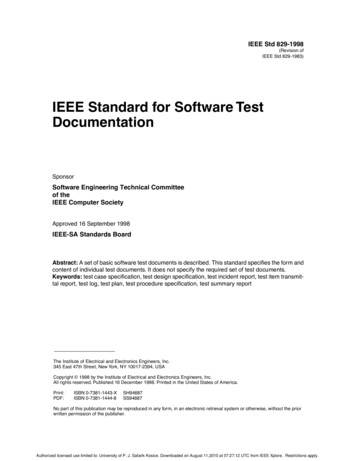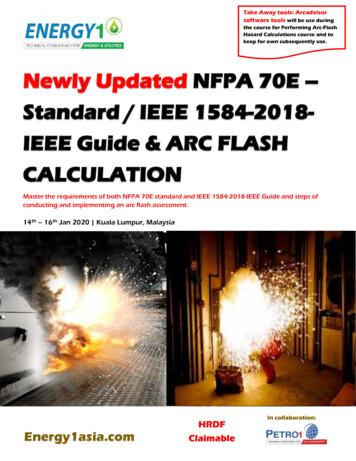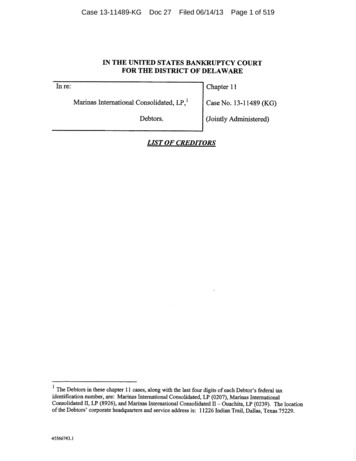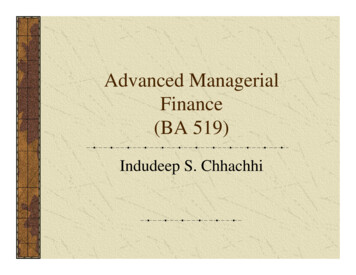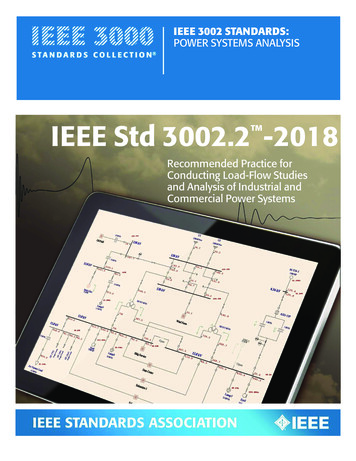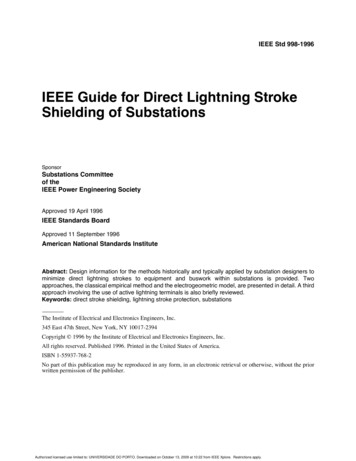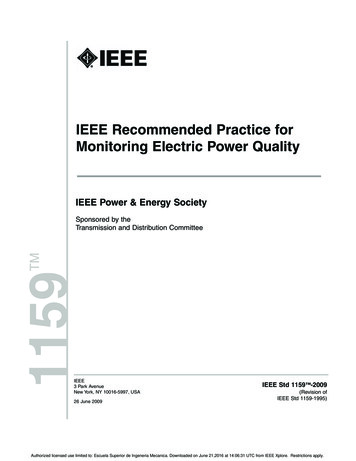
Transcription
IEEE Standard 519-2014Compliances, Updates, Solutions and Case StudiesPresented by: Dr John Cheng, CEng, CEM, CEA, CMVPConfidential Property of Schneider Electric
Agenda1. Introduction: Harmonics Overview2. History of IEEE STD 519, and comparison betweenIEEE STD 519 (2014 vs 1992)3. How SE helped you to achieve IEEE STD 519-20144. Case Studies5. ConclusionsConfidential Property of Schneider Electric Page 2
IntroductionHarmonics OverviewConfidential Property of Schneider Electric Page 3
Why is there harmonic in the electrical network?Linear loads versus Nonlinear loadsLinear loads:Nonlinear MOSFETBJTIGBTSource: IEC 61000-3-6:1996Confidential Property of Schneider Electric Page 4
How does the harmonic created?Single phase full-bridge rectifier circuitUiCiCiVDC bus voltage UDC bus capacitorcurrent (IC)Supplycurrent(i)Supplyvoltage (V)V E - ZsiConfidential Property of Schneider Electric Page 5
“Evolution” of Power FactorsWith linear vs. nonlinear loadsElectrical system with ONLY linear loadsElectrical system with Nonlinear loadsQ kVAr (ReactivePower)S kVA(Apparent Power)D kVAH(Distortion Power)θTPF (True/Total Power Factor)P kW (Real Power)S kVA V rms I rms True/Total Power Factor :P2 Q2 D2cos TPF cos dispPF cos distPFDisplacement Power FactorkW(Fundamental Components): cos dispPF kVA( fundamenta l )Distortion Power Factor(Harmonic Components):Confidential Property of Schneider Electric Page 6cos distPF 11 THDv2 1 THDi2
Effects of HarmonicsDifferent PerspectivesEngineering PerspectiveBusiness Perspective Nuisance tripping of circuit breaker Increased maintenance and replacement cost (OPEX) Harmonic resonance Interruptions and downtimes cost Capacitor bank failure Reduced system capacity and thus increase CAPEX byunnecessary of expansion. Excessive heating Transformer overheating Skin effects on cables for higher harmonic orders Motor winding burnt (dv/dt) & hunting Neutral overloading (double neutral) Causing EMI to sensitive signals Problems to generatorsConfidential Property of Schneider Electric Page 7
History of IEEE Standard 519Confidential Property of Schneider Electric Page 8
The Journey of IEEE Standard 519Revision Years: 1981, 1992 and 2014Sponsor by Static Power Converter Committee of theIndustry Applications SocietyConfidential Property of Schneider Electric Page 9Sponsors by Transmission & Distribution Committee of theIEEE Power Engineering Society and Static PowerConverter Committee of the IEEE Industry ApplicationsSocietySponsor by Transmission & Distribution Committee of theIEEE Power Engineering Society
Main FocusesShifting of main focuses depending on the sponsors.IEEE STD 519-1981IEEE STD 519-1992IEEE STD 519-2014 Title: IEEE Guide for Harmonic Control andReactive Compensation of Static PowerConverters (54 pages) Title: IEEE Recommended Practices andRequirements for Harmonic Control inElectrical Power System s(101 pages) Title: IEEE Recommended Practice andRequirements for Harmonic Control inElectrical Power System s(29 pages) Sponsor : Static Power Converter Committee(SPCC) of the Industry Applications Society(IAS) Sponsors: Transmission & DistributionCommittee of the IEEE PES & SPCC of theIEEE IAS Sponsor: Transmission & DistributionCommittee of the IEEE Power EngineeringSociety (PES) Introduce the basic of harmonics. In-depth discussion about harmonics No discussion about harmonic fundamentals Educational in nature Educational and informative in nature. Clarification and limits setting in nature. Introduces quantifying factor for harmonicssuch as DF, TIF Introduces Total Harmonic Distortion (THD)and Total Demand Distortion (TDD). Introduces statistical evaluation (Very shortand Shot time harmonic measurements) Focus on the recommended practices for: Focus on: Focus on: Line notch limitsVoltage distortion limitsTelephone influence limitsFlicker limitsConfidential Property of Schneider Electric Page 10 Recommended practices for IndividualconsumersRecommended practices for UtilitiesRecommended methodology forevaluating new harmonic sources Harmonic measurementsRecommended harmonic limits for voltageand current distortion
Comparison between IEEE STD 519 (2014 vs 1992)Confidential Property of Schneider Electric Page 11
Section 1: OverviewSection 1.1: ScopeSection 1.2: PurposeIEEE Standard 519 - 2014Confidential Property of Schneider Electric Page 12
Redefining the Purpose of IEEE 519 in 2014 documentFocusing on Point of Common Coupling (PCC)IEEE STD 519-1992IEEE STD 519-2014 Page 75. Focuses on the PCC with the consumer-utility interface, butcontradicting definition of PCC in latter statement. Page 2. Clarify on the PCC. The recommendation described in this document attempts to reducethe harmonic effects at any point in the entire system by establishinglimits on certain harmonic indices (currents and voltages) at the point ofcommon coupling (PCC), a point of metering, or any point as long asboth the utility and the consumer can either access the point for directmeasurement of the harmonic indices meaningful to both or canestimate the harmonic indices at point of interference (POI) throughmutually agreeable methods. Within an industrial plant, the PCC is the point between the nonlinearload and other loads.Confidential Property of Schneider Electric Page 13 The limits in this recommended practice are intended for application ata point of common coupling (PCC) between the system owner oroperator and a user, where the PCC is usually taken as the point in thepower system closest to the user where the system owner or operatorcould offer service to another user. Frequently for service to industrial users (i.e., manufacturing plants) viaa dedicated service transformer, the PCC is at the HV side of thetransformer. For commercial users (office parks, shopping malls, etc.) suppliedthrough a common service transformer, the PCC is commonly at the LVside of the service transformer.
Point of Common Coupling in SummaryIEEE STD 519-2014PCC at HV side for Industrial usersConfidential Property of Schneider Electric Page 14PCC at LV side for commercial users
Who’s Responsibility?Utility and/or Users?IEEE STD 519-1992IEEE STD 519-2014 Mentioned briefly in the “Foreword” page. Not considered as part of thestandards guidelines. Listed clearly in “Section 1.2 - Purpose” (page 2) This recommended practice recognizes the responsibility that usershave not to degrade the voltage of the utility serving other users byrequiring nonlinear currents from the utility. It also recognizes the responsibility of the utilities to provide users withclose to a sine wave of voltage.Confidential Property of Schneider Electric Page 15 The limits in this recommended practice represent a sharedresponsibility for harmonic control between system owners or operatorsand users. Maintaining harmonic voltages below these levels necessitates that All users limit their harmonic current emissions to reasonable valuesdetermined in an equitable manner based on the inherentownership stake each user has in the supply system and Each system owner or operator takes action to decrease voltagedistortion levels by modifying the supply system impedancecharacteristics as necessary.
Section 2: Normative ReferencesIEEE Standard 519 - 2014Confidential Property of Schneider Electric Page 16
ReferencesIEEE STD 519-2014 reference to IEC61000-4-XIEEE STD 519-1992IEEE STD 519-2014 Page 8 Page 3 10 references. 4 references, but 2 are the same (IEC 61000-4-15 and IEEE STD1453) All references are referenced to IEEE Standards and ANSI (AmericanNational Standard)Confidential Property of Schneider Electric Page 17 All references are referenced to IEC Standards. IEC Standard 61000-4-7, General Guide on Harmonics and InterharmonicsMeasurement and Instrumentation, for Power Supply Systems andEquipment Connected Thereto. IEC Standard 61000-4-30, Power Quality Measurement Methods. IEC Standard 61000-4-15, Testing and Measurement Techniques—Flickermeter—Functional and Design Specifications. IEEE Std 1453 , IEEE Recommended Practice—Adoption of IEC 610004-15:2010, Electromagnetic compatibility (EMC)—Testing andMeasurement Techniques—Flickermeter—Functional and DesignSpecifications
Section 3: DefinitionsIEEE Standard 519 - 2014Confidential Property of Schneider Electric Page 18
New and Redefined DefinitionsIEEE STD 519-2014 – page 3New DefinitionsRedefined Definitions maximum demand load current: This current value is established atthe point of common coupling and should be taken as the sum of thecurrents corresponding to the maximum demand during each of thetwelve previous months divided by 12. short-circuit ratio: At a particular location, the ratio of the availableshort-circuit current, in amperes, to the load current, in amperes. notch: A switching (or other) disturbance in the normal power voltagewaveform, lasting less than 0.5 cycles, which is initially of oppositepolarity than the waveform and is thus subtracted from the normalwaveform in terms of the peak value of the disturbance voltage. Thisincludes complete loss of voltage for up to 0.5 cycles. point of common coupling (PCC): Point on a public power supplysystem, electrically nearest to a particular load, at which other loadsare, or could be, connected. The PCC is a point located upstream ofthe considered installation.Confidential Property of Schneider Electric Page 19 total demand distortion (TDD): The ratio of the root mean square of theharmonic content, considering harmonic components up to the 50thorder and specifically excluding interharmonics, expressed as apercent of the maximum demand current. Harmonic components oforder greater than 50 may be included when necessary. total harmonic distortion (THD): The ratio of the root mean square ofthe harmonic content, considering harmonic components up to the 50thorder and specifically excluding interharmonics, expressed as apercent of the fundamental. Harmonic components of order greaterthan 50 may be included when necessary.
Section 4: Harmonic MeasurementsSection 4.1: Measurement window widthSection 4.2: Very short time harmonic measurementsSection 4.3: Short time harmonic measurementsSection 4.4: Statistical evaluationIEEE Standard 519 - 2014Confidential Property of Schneider Electric Page 20
Instrument CompliancesNew compliance guidelines (IEC 61000-4-7 & IEC 61000-4-30)IEEE STD 519-1992IEEE STD 519-2014 Page 68-74, Section 9: Measurement Page 4 Detailing all the requirements for harmonic measurement Reference directly to IEC Standards. No reproduction of IEEE STD519-1992 Section 9. 9.2 Basic Equipment Used for the Analysis of NonsinusoidalVoltages and Currents 9.3 Requirements for Instrument Response 9.4 Presentation of Harmonic Data 9.5 Transducers for Harmonic MeasurementsConfidential Property of Schneider Electric Page 21 For the purposes of assessing harmonic levels for comparison with therecommended limits in this document, any instrument used shouldcomply with the specifications of IEC 61000-4-7 and IEC 61000-4-30.
New Terminologies for Harmonic MeasurementsNewly introduced in IEEE STD 519-2014 page 5, and not in IEEE STD 519-1992.Very short time harmonic measurementsShort time harmonic measurements Very short time harmonic values are assessed over a 3-second intervalbased on an aggregation of 15 consecutive 12 (10) cycle windows for60 (50) Hz power systems. Short time harmonic values are assessed over a 10-minute intervalbased on an aggregation of 200 consecutive very short time values fora specific frequency component. Individual frequency components are aggregated based on an rmscalculation as shown in Equation (1). The 200 values are aggregated based on an rms calculation as shownin Equation (2). where F represents voltage (V) or current (I) in rms value.n represents the harmonic order,i is a simple counterSubscript vs “very short.”Confidential Property of Schneider Electric Page 22 where F represents voltage (V) or current (I), in rms value n represents the harmonic order i is a simple counter Subscript sh is “short.”
Specify Durations and Statistical EvaluationIEEE STD 519-2014 Pg 5; & IEEE STD 519-1992 no duration and only has 95th percentile.Very short time harmonic measurementsShort time harmonic measurements Measurement duration: 24 hours (1 day) Measurement duration: 7-day period (1 week) For very short time harmonic measurements, the 99th percentile value(i.e., the value that is exceeded for 1% of the measurement period)should be calculated for each 24-hour period for comparison with therecommend limits in Clause 5. For short time harmonic measurements, the 95th and 99th percentilevalues (i.e., those values that are exceeded for 5% and 1% of themeasurement period) should be calculated for each 7-day period forcomparison with the recommended limits in Clause 5. Applied to both voltage and current harmonics. These statistics should be used for both voltage and current harmonicswith the exception that the 99th percentile short time value is notrecommended for use with voltage harmonics. Interpretation: Current harmonics evaluate based on 95th and 99th percentile. Voltage harmonics evaluate based on 95th percentile only.Confidential Property of Schneider Electric Page 23
Section 5: Recommended harmonic limitsSection 5.1: Recommended harmonic voltage limitsSection 5.2: Recommended current distortion limits for systems nominally rated 120 V through69 kVSection 5.3: Recommended current distortion limits for systems nominally rated above 69 kVthrough 161 kVSection 5.4: Recommended current distortion limits for systems nominally rated above 161 kVSection 5.5: Recommendations for increasing harmonic current limitsIEEE Standard 519 - 2014Confidential P
IEEE Standard 519-2014 Compliances, Updates, Solutions and Case Studies Confidential Property of Schneider Electric Presented by: Dr John Cheng, CEng, CEM, CEA, CMVP . Agenda 1. Introduction: Harmonics Overview 2. History of IEEE STD 519, and comparison between IEEE STD 519 (2014 vs 1992) 3. How SE helped you to achieve IEEE STD 519-2014 4. Case Studies 5. Conclusions Confidential


